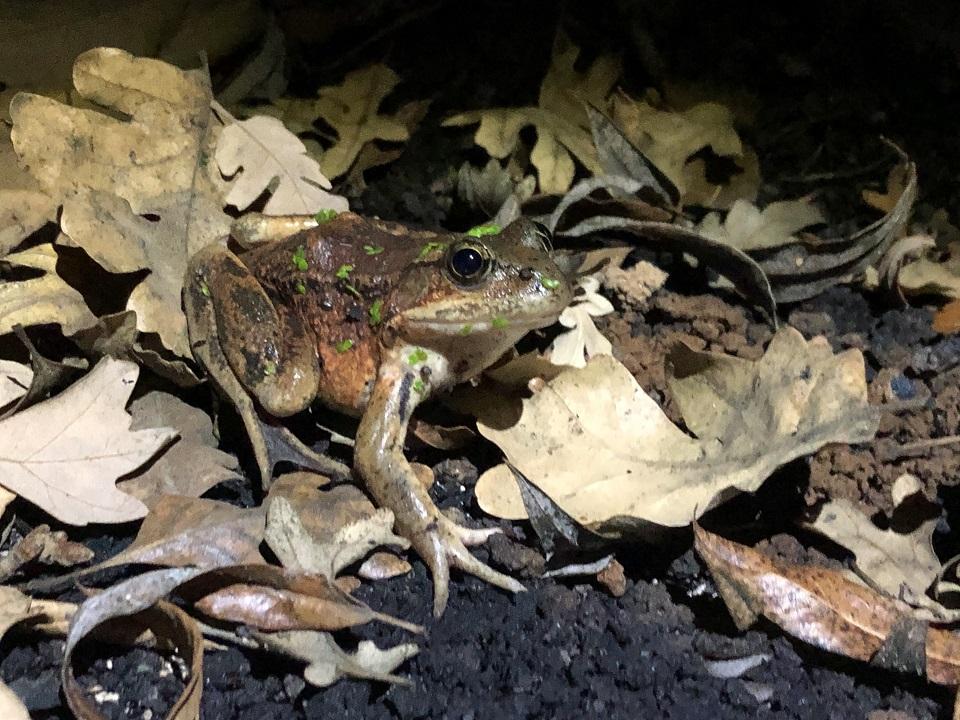
A California red-legged frog shortly after the Woolsey Fire destroyed much of their habitat/NPS.
Hundreds of frogs from the Santa Monica Mountains National Recreation Area perished in the Woolsey Fire. Seven months after the blaze, an initiative that began in 2014 to reintroduce the threatened California red-legged frog (Rana draytonii) is struggling to regain its footing. The species is both federally threatened and a California state species of special concern.
In the weeks prior to the fire, the rare amphibians thrived as they preyed on insects and reproduced in two of the four streams spread throughout the mountains. In a dragic double-whammy, the fire destroyed much of their habitat and was immediately followed by a season of heavy rainfall, causing debris flows that filled the streams with silt and mud.
Three of the four reintroduction streams were “annihilated,” according to Katy Delaney, a National Park Service ecologist who has been leading the project for more than five years. Prior to the reintroduction, the frogs had not survived within the park since the 1970s.
“With three of the four sites, there is no aquatic habitat left and not much vegetation,” she continued. “I don’t even know if they are alive. They were doing great before the fire.”
Prior to Woolsey, frogs in varying life stages could be found in each of these streams - from tadpoles to grown adults. After the fire burned 88% of the National Park Service land, Delaney has seen one lone frog struggling in one of the reintroduction streams. Another biologist witnessed another single frog post-fire and post- debris flow at another site. No other sightings have occured.
“If there is a frog here and there, that’s great but there are no breeding pools left,” Delaney said. “They are all filled in with debris.”
A population discovered north of the 101 Freeway in the nearby Simi Hills in 1999 has been used to replenish the species in four spots in the mountains for the past five years. Scientists and park staff hoped that the translocated populations would eventually mature, mate, and reproduce on their own. A pivotal moment for the project came in March of 2017 when the first egg masses were found in one of the reintroduction streams, a critical step forward as breeding occured without human interference.
The silver lining to the otherwise doomed project seems to be the source population in the Simi Hills. Although that location was also burned in the fire, it is located at a lower gradient and the resulting debris flow was minimal in comparison to the sites in the Santa Monica Mountains. The frogs there seem to have survived relatively unscathed.
During a night survey completed in December of 2018 within that particular area, biologists found 90 frogs in the charred landscape. Delaney even danced a jig as she and another biologist kept counting the frogs as they walked beneath blackened trees and brushed past sooty branches.
In February of this year, after the federal government reopened after a month-long shutdown, the team of biologists discovered six egg masses in the source population - an astounding discovery. But Delaney did not want to take the frogs or egg masses in the source population for granted, as she thought the frogs looked skinny and would fail to breed. She enlisted the help of the Santa Barbara Zoo, a partner in the study, and together they transported 1,000 eggs to hatch into tadpoles in quarantined tanks at the zoo. The resulting tadpoles were eventually split between two reintroduction sites: one with minor and one with serious damage.
California red-legged frogs require deep pools of year-round water, which are not easy to find in the arid climate of the Santa Monica Mountains. Many of the streams in the Santa Monica Mountains are infested with non-native species like crayfish, which can prey on frog eggs and tadpoles. Biologists looked for other pools of water to replace the previous ones burned in the fire but could not find suitable restoration areas.
Since the tadpoles were deposited in the sites a couple of months ago, there have been no signs of them. But that is not unusual, Delaney says. By contrast, biologists also returned to the source population stream to check for frogs and egg masses after the rainstorms. Luckily, they recorded another 78 egg masses for a total of 84 in the source population this year.
Partners in the reintroduction project include California State Parks, the Mountains Recreation and Conservation Authority, the Santa Barbara Zoo, the Santa Monica Bay Restoration Commission, the Santa Monica Mountains Conservancy, the U.S. Fish and Wildlife Service and the U.S. Geological Survey.



Add comment